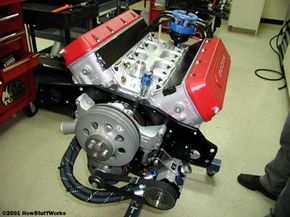Tires are another critical component on the race car. A high-speed blowout can be incredibly dangerous.
Like the tires on your car, NASCAR tires are radial tires, but that is about the only similarity. The tires on a NASCAR race car have some very special requirements. They have to remain stable at very high temperatures and speeds, provide incredible traction and be changed very quickly.
Nitrogen Instead of Air
Most of the teams remove the air from the tires and replace it with nitrogen. Compressed nitrogen contains less moisture than compressed air. When the tire heats up, moisture in the tire vaporizes and expands, causing the pressure inside the tire to increase. Even small changes in tire pressure can noticeably affect the handling of the car. By using nitrogen instead of air, the teams have more control over how much the pressure will increase when the tires heat up.
Inner and Outer Tires
On tracks that are more than 1 mile (1.6 km) long, where speeds are faster, NASCAR rules require that tires contain an inner liner. This is essentially a second tire mounted inside the first tire. It mounts to the rim and has its own separate air supply. If the outer tire blows, the inner tire is still intact, allowing the driver to bring the car to a controlled stop.
Different Compounds for Different Tracks
NASCAR regulates which tire compounds are used on each track. The tire compound is the material the tire is made from -- a softer compound can provide more grip but wears faster, while a harder compound will last longer. Each track causes tires to wear differently, and the inside tires wear differently than the outside tires. Track surface, number of turns, tightness of turns and type of banking are all factors that determine how a tire will wear. Since tires are so critical for safety, NASCAR and Goodyear have determined the best compounds for the inside and outside tires for each track, and these are the tire compounds that the teams are required to use.
Treadless Design
NASCAR tires look completely bald, but that's not because they are worn out. It is by design. On a dry track, tires can generate more traction if more of their sticky rubber is in contact with the ground. Putting a tread pattern on the tire helps in wet weather, but in dry weather it is better to have the whole tire touching the ground. That's why NASCAR races stop whenever the track is wet.
Quick Change
How do they get the tires on and off so fast?
You may have seen a NASCAR pit stop before. In 12 to 14 seconds, seven people manage to completely refuel the car and change all four tires. This requires incredible hand-eye coordination, but there are a couple of tricks the teams use to make things a little easier. When the new tire is placed onto the car, the five lug nuts are already attached to the wheel by an adhesive. The studs are long and have no threads for the first three-quarters of an inch. This ensures that the lug nuts do not get cross-threaded, making it easier for the tire to be positioned.









